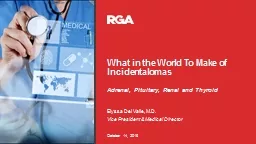PPT-What in the World To Make of
Author : messide | Published Date : 2020-06-17
Incidentalomas Adrenal Pituitary Renal and Thyroid Elyssa Del Valle MD October 14 2016 Vice President amp Medical Director Terminology Nodule Lesion Mass Tumor Nodule
Presentation Embed Code
Download Presentation
Download Presentation The PPT/PDF document "What in the World To Make of" is the property of its rightful owner. Permission is granted to download and print the materials on this website for personal, non-commercial use only, and to display it on your personal computer provided you do not modify the materials and that you retain all copyright notices contained in the materials. By downloading content from our website, you accept the terms of this agreement.
What in the World To Make of: Transcript
Download Rules Of Document
"What in the World To Make of"The content belongs to its owner. You may download and print it for personal use, without modification, and keep all copyright notices. By downloading, you agree to these terms.
Related Documents














